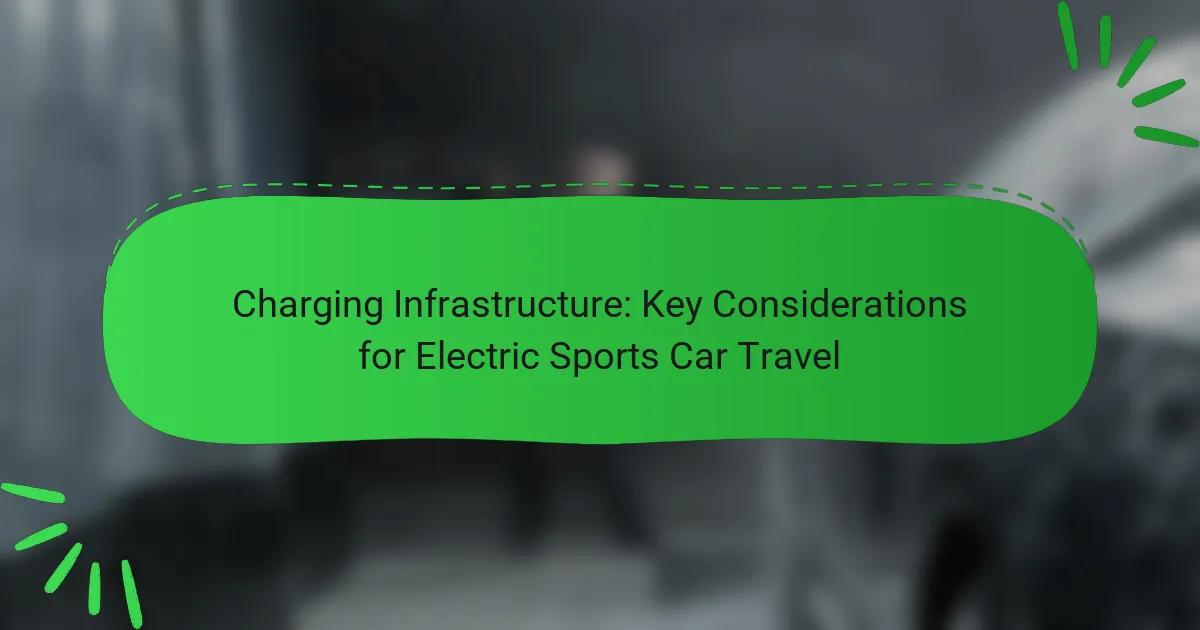Electric sports car travel relies heavily on effective charging infrastructure to ensure convenience and range. Key considerations include the availability of fast chargers, strategic placement of charging stations, and reliable grid connectivity. Factors influencing charging speed and efficiency, such as power output and battery capacity, are crucial for optimizing the travel experience. Additionally, understanding regulatory requirements and emerging trends in charging technology can enhance accessibility and user satisfaction.
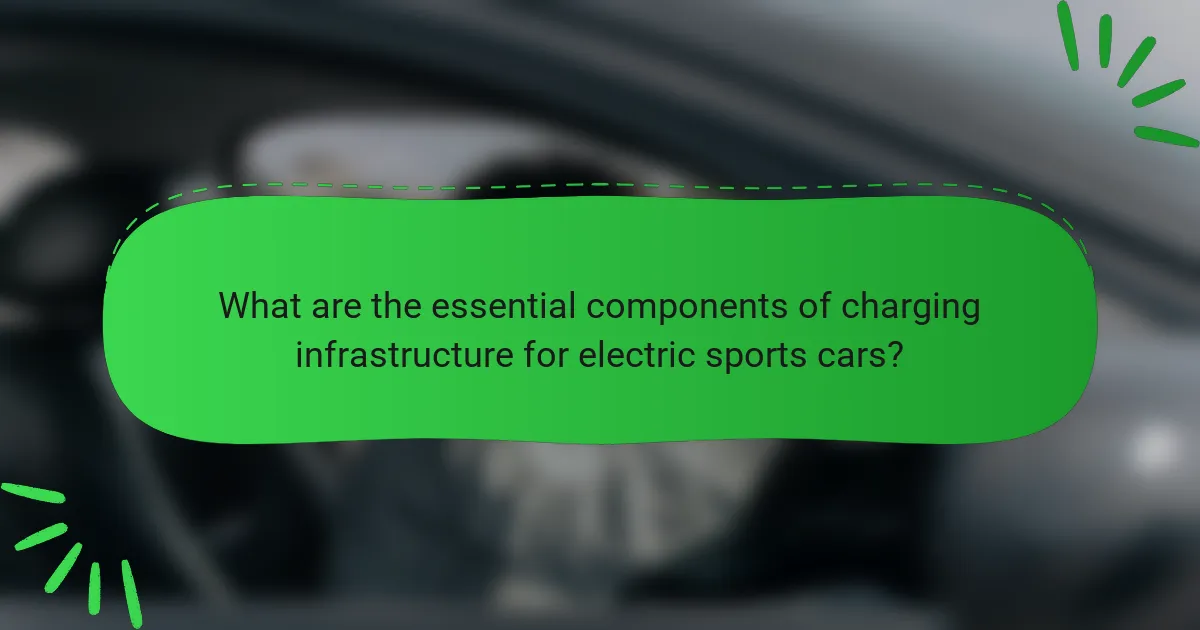
What are the essential components of charging infrastructure for electric sports cars?
Charging infrastructure for electric sports cars includes fast chargers, charging stations, and grid connectivity. Fast chargers deliver high power levels, enabling quick charging times. Charging stations should be strategically placed along travel routes for accessibility. Grid connectivity ensures reliable power supply and integration with renewable energy sources. Additionally, user-friendly payment systems enhance the charging experience. Advanced features like real-time availability updates and reservation systems can further optimize usage.
How do different charging station types impact travel experience?
Different charging station types significantly enhance the travel experience for electric sports car users. Fast chargers reduce downtime, enabling quicker stops and longer journeys. In contrast, standard chargers may require longer wait times, impacting travel schedules.
Access to various charging station types, such as Level 2 and DC fast chargers, allows for flexibility in planning trips. Locations with fast chargers often feature amenities, improving the overall travel experience. Additionally, the availability of charging networks influences route planning and convenience, ensuring that electric sports car drivers can enjoy their journeys without interruption.
Which technologies are prevalent in charging infrastructure?
Charging infrastructure for electric sports cars commonly utilizes fast-charging stations, wireless charging, and battery swap technology. Fast-charging stations provide high power output, typically between 50 kW to 350 kW, enabling rapid recharging. Wireless charging employs inductive technology, allowing vehicles to charge without physical connections. Battery swap technology offers a unique solution by enabling drivers to exchange depleted batteries for fully charged ones in minutes, enhancing convenience and reducing downtime. These technologies collectively enhance the usability and accessibility of electric sports car travel.

What are the key factors influencing charging speed and efficiency?
Charging speed and efficiency are influenced by several key factors. These include the power output of the charging station, the vehicle’s battery capacity, and the charging technology used.
Higher power output from charging stations, such as those offering DC fast charging, significantly reduces charging time. For example, a 350 kW charger can provide up to 80% battery capacity in about 30 minutes.
The battery capacity of the electric sports car also plays a role. Larger batteries can store more energy but may take longer to charge if the charging station’s power output is low.
Additionally, the charging technology, including standards like CCS and CHAdeMO, affects compatibility and charging speed. Cars equipped with advanced thermal management systems can optimize charging efficiency, enhancing overall performance during travel.
How does the power output of charging stations vary?
The power output of charging stations varies significantly based on their type and location. Fast charging stations typically deliver between 50 kW to 350 kW, while standard Level 2 chargers offer around 7 kW to 22 kW. This variation impacts the charging time for electric sports cars, with higher outputs reducing wait times. Additionally, charging infrastructure may differ in urban versus rural areas, affecting accessibility and convenience for drivers.
What is the role of battery capacity in charging performance?
Battery capacity significantly influences charging performance by determining how much energy can be stored and how quickly it can be replenished. A higher capacity allows for longer travel distances and faster charging times, enhancing the overall efficiency of electric sports car travel. For instance, a battery with a capacity of 100 kWh can provide more energy than one with 60 kWh, resulting in less frequent charging stops during long journeys. Additionally, advancements in charging technology, such as ultra-fast chargers, can optimize the benefits of larger battery capacities, enabling quicker turnaround times at charging stations.
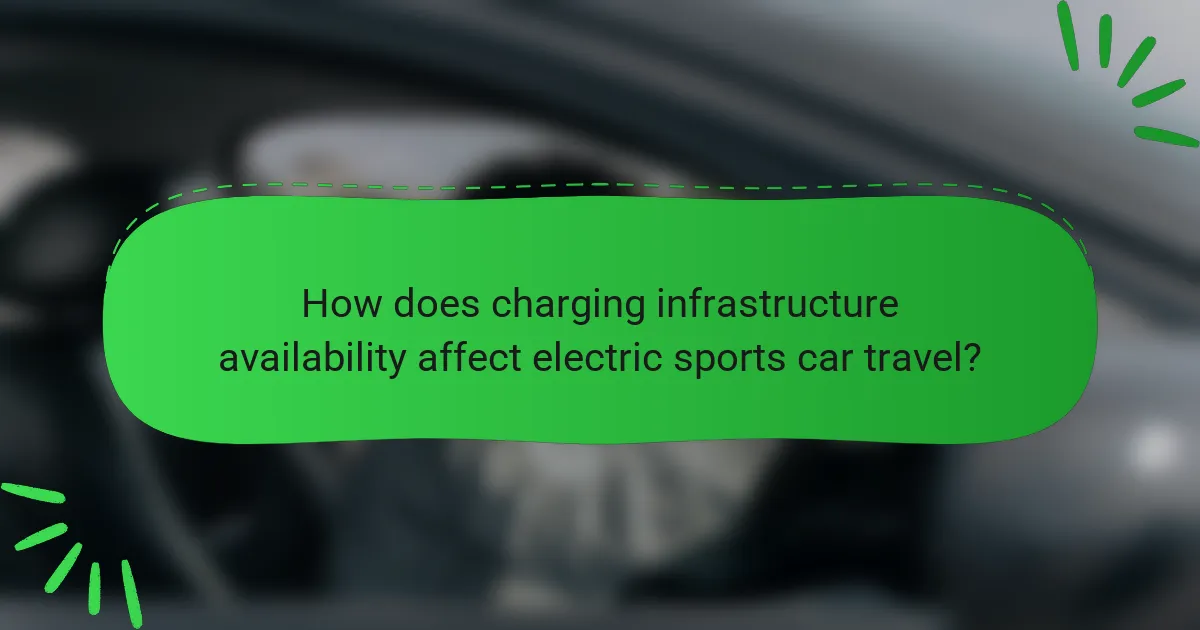
How does charging infrastructure availability affect electric sports car travel?
Charging infrastructure availability significantly impacts electric sports car travel by determining convenience and range. A well-developed network of charging stations reduces range anxiety and enhances travel flexibility.
For electric sports cars, fast-charging stations are crucial; they can deliver over 150 kW, allowing for quicker charging times compared to standard outlets. The presence of these stations along popular routes enables longer trips without long delays.
Moreover, regions with extensive charging infrastructure attract more electric sports car owners, as they seek assurance of accessibility. This trend influences car manufacturers to prioritize models that cater to long-distance travel, promoting innovations in battery technology and charging solutions.
Ultimately, the availability of charging infrastructure shapes the overall experience of electric sports car travel, affecting consumer choices and the market’s growth trajectory.
What geographic regions have the most developed charging networks?
Regions with the most developed charging networks include Europe, North America, and parts of Asia. Europe leads with extensive infrastructure, especially in countries like Norway and Germany, supporting electric sports car travel. North America, particularly California, has a growing network of fast chargers. In Asia, China is rapidly expanding its charging stations, enhancing accessibility for electric vehicle users. These regions prioritize charging infrastructure to facilitate the increasing demand for electric sports cars.
Which urban areas are leading in charging station installations?
The urban areas leading in charging station installations include Los Angeles, New York City, San Francisco, Seattle, and Chicago. These cities are prioritizing electric vehicle infrastructure to support growing demand. For instance, Los Angeles has over 1,600 public charging stations, reflecting a commitment to sustainable travel. Additionally, New York City is expanding its network to enhance accessibility for electric sports car users.
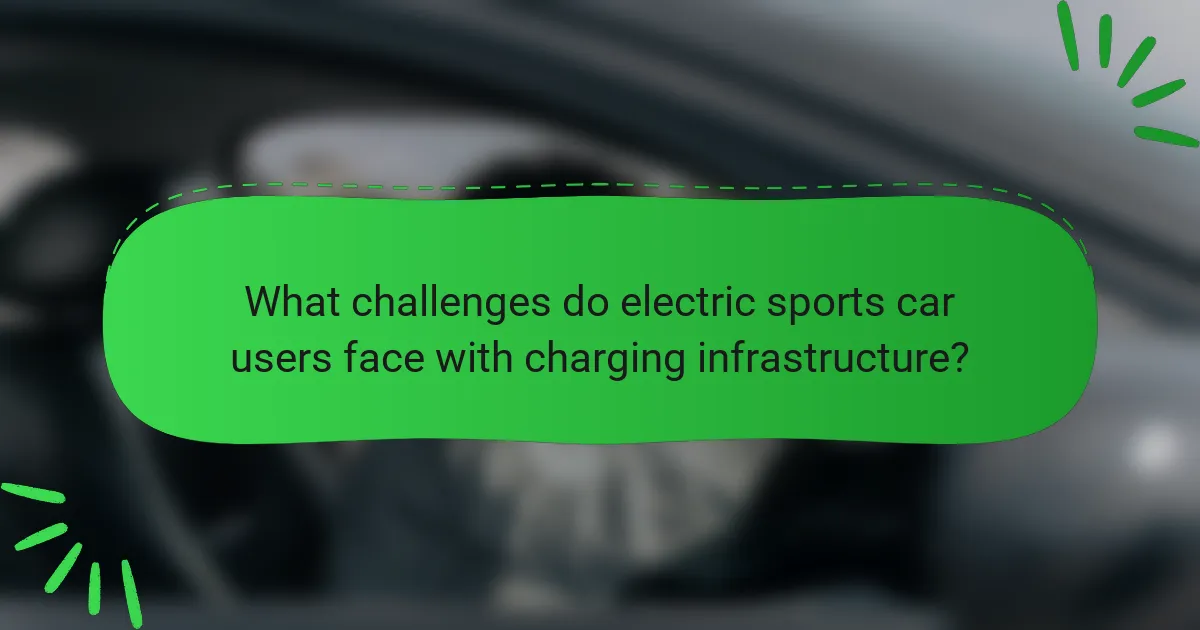
What challenges do electric sports car users face with charging infrastructure?
Electric sports car users face significant challenges with charging infrastructure, primarily due to limited charging station availability and longer charging times.
The current charging network often lacks sufficient fast-charging stations, especially in remote areas. Users may encounter longer wait times at busy stations, impacting travel plans. Additionally, the charging speed varies by station type; DC fast chargers provide quicker charging than Level 2 chargers, yet not all locations offer fast options.
Moreover, compatibility issues arise with different charging connectors, which can hinder the charging experience. Users may need adapters or find themselves at stations that do not support their vehicle’s charging standard.
Lastly, the lack of real-time information on charging station availability can lead to uncertainty during trips, complicating route planning. Addressing these challenges is essential for enhancing the electric sports car travel experience.
How do range anxiety and charging accessibility impact user experience?
Range anxiety and charging accessibility significantly affect user experience in electric sports car travel. Limited charging stations can deter potential users, while convenient access to fast chargers enhances confidence and satisfaction.
Charging infrastructure directly influences driving range perceptions. A robust network of charging points reduces anxiety, allowing drivers to plan trips without fear of running out of power. Fast charging options further improve the experience, enabling quick stops during long journeys.
User experience is also shaped by the availability of charging stations at popular destinations. Locations such as hotels, restaurants, and shopping centers that offer charging facilities attract electric sports car owners. This accessibility fosters a positive relationship with electric vehicle technology.
Overall, addressing range anxiety and improving charging accessibility are essential for enhancing the user experience in electric sports car travel.
What are the common technical issues encountered at charging stations?
Common technical issues at charging stations include connectivity problems, slow charging speeds, and compatibility issues with different electric vehicle models. These challenges can hinder the overall charging experience for electric sports car travelers. Regular maintenance and software updates are essential to mitigate these problems. Additionally, user education on station operation can enhance efficiency and satisfaction.
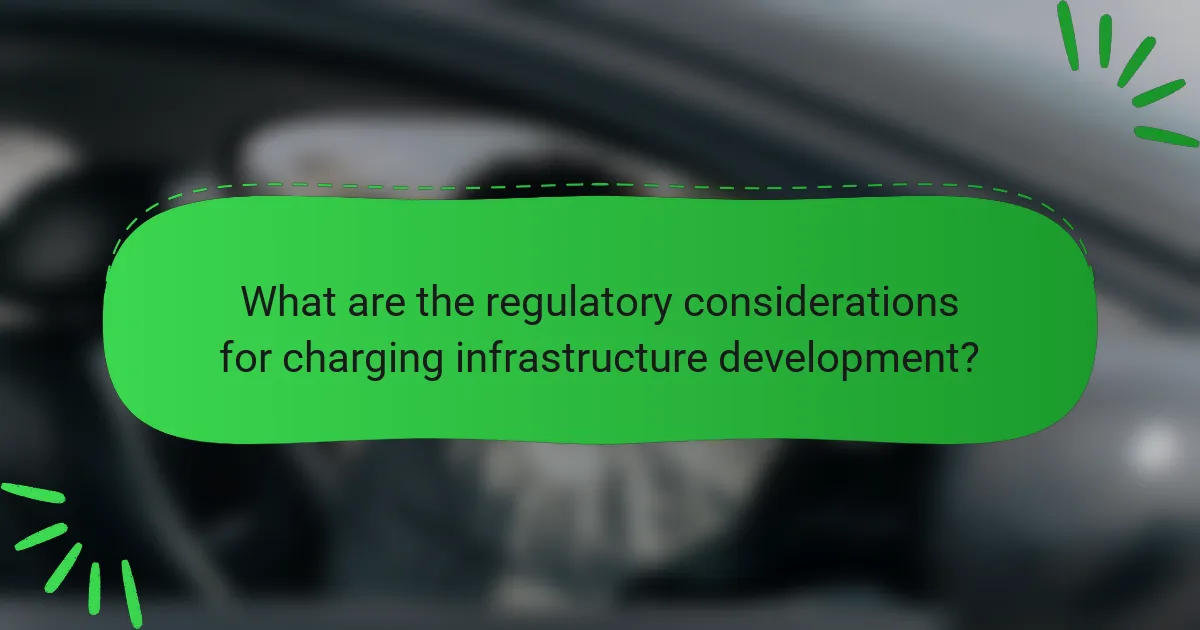
What are the regulatory considerations for charging infrastructure development?
Regulatory considerations for charging infrastructure development include compliance with safety standards, zoning laws, and utility regulations. These factors ensure safe and efficient operation of charging stations. Local governments may impose specific requirements for installation and operation. Additionally, incentives may be available to promote infrastructure growth. Understanding these regulations is crucial for developers in the electric sports car market.
How do government incentives shape charging station proliferation?
Government incentives significantly enhance the proliferation of charging stations for electric sports cars. These incentives include tax credits, grants, and subsidies aimed at reducing installation costs. As a result, more businesses and municipalities invest in charging infrastructure, improving accessibility for electric vehicle users. For instance, the federal government offers a tax credit of up to 30% for the installation of charging stations, which directly influences the number of new installations. Additionally, state programs often provide matching funds or additional grants, further accelerating growth in this sector. Enhanced charging infrastructure not only supports electric sports car travel but also contributes to broader sustainability goals.
What environmental regulations must be considered in infrastructure planning?
Environmental regulations in infrastructure planning for charging stations include land use, emissions standards, and environmental impact assessments. Compliance with local zoning laws is essential to ensure appropriate site selection. Additionally, regulations may mandate the integration of renewable energy sources to minimize carbon footprints. Adhering to these guidelines promotes sustainable development and supports electric vehicle adoption.
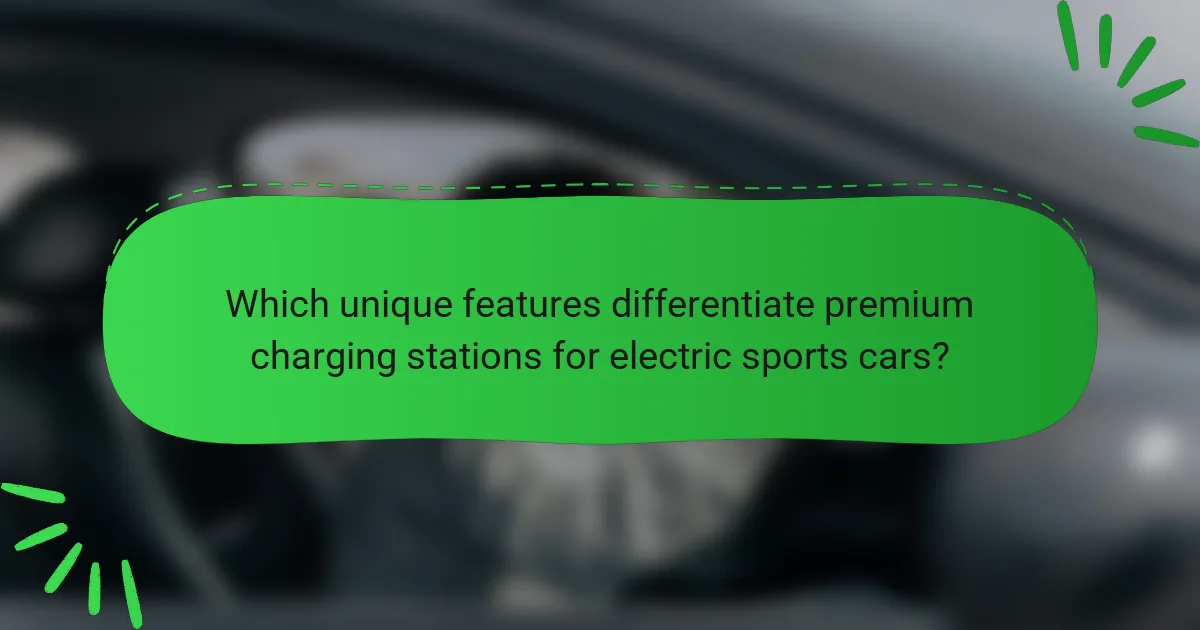
Which unique features differentiate premium charging stations for electric sports cars?
Premium charging stations for electric sports cars feature faster charging speeds, advanced connectivity, and superior design aesthetics. These stations often support high-capacity charging, enabling quicker replenishment of battery life.
Key unique features include:
– High power output (up to 350 kW)
– User-friendly interfaces with touchscreens
– Real-time availability updates via mobile apps
– Integration with renewable energy sources
– Enhanced security features such as RFID access
– Premium location placements near luxury amenities
These attributes ensure a seamless and efficient charging experience tailored to the needs of electric sports car owners.
What amenities enhance the user experience at high-end charging locations?
High-end charging locations enhance user experience through premium amenities. These may include comfortable lounges, high-speed Wi-Fi, gourmet food options, and concierge services. Additionally, features like vehicle maintenance stations and charging reservation systems cater to luxury needs. Such amenities elevate the overall charging experience for electric sports car travelers.
How do exclusive partnerships between automakers and charging networks influence service quality?
Exclusive partnerships between automakers and charging networks significantly enhance service quality. These collaborations ensure better integration of charging infrastructure with vehicle technology. Automakers can optimize charging speeds and accessibility, directly benefiting electric sports car users. For instance, dedicated fast-charging stations can reduce downtime during travel, improving overall user experience. Additionally, exclusive partnerships often lead to advanced features like real-time availability updates and seamless payment options, further elevating service quality.
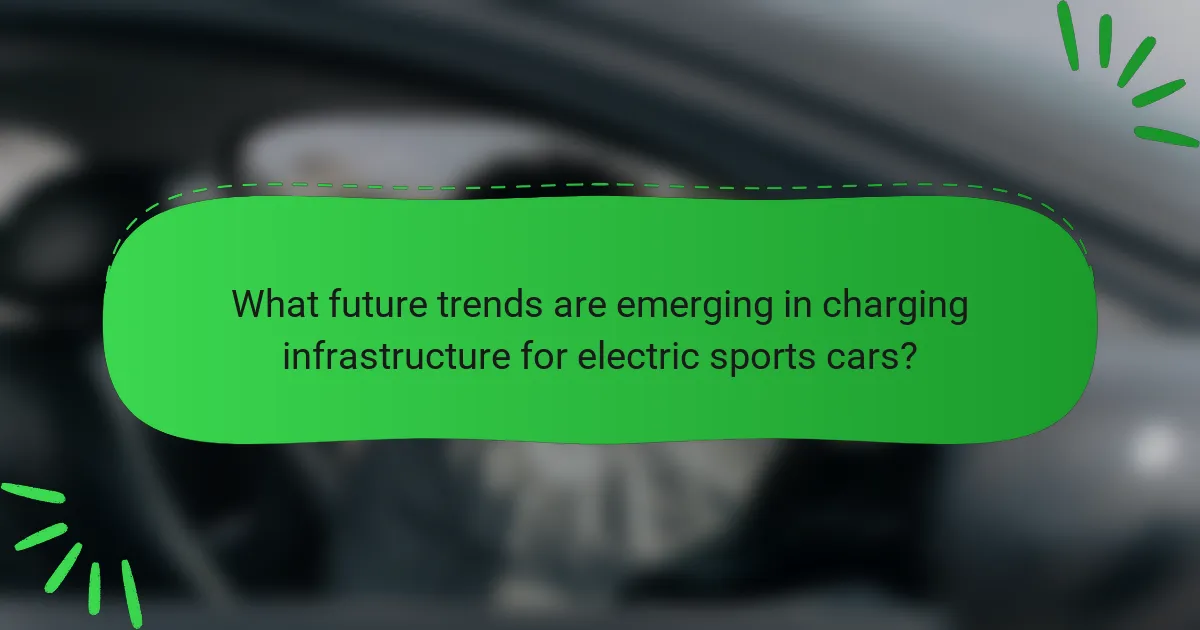
What future trends are emerging in charging infrastructure for electric sports cars?
Emerging trends in charging infrastructure for electric sports cars focus on faster charging, increased accessibility, and smart technology integration. Ultra-fast chargers can significantly reduce charging time, enabling quicker pit stops. Expanding charging networks in urban areas and along highways enhances convenience for drivers. Additionally, smart charging solutions, including vehicle-to-grid technology, optimize energy use and promote sustainability. These advancements will enhance the overall electric sports car experience, making it more practical and appealing.
How is fast charging technology evolving?
Fast charging technology is rapidly advancing to support electric sports car travel. Innovations include higher power outputs, improved battery management systems, and widespread charging networks.
New fast charging stations now offer power levels exceeding 350 kW, significantly reducing charging times. As a result, electric sports cars can achieve an 80% charge in under 20 minutes.
Battery technology is evolving with solid-state batteries, which promise greater energy density and faster charging capabilities. This unique attribute may enhance performance and range for electric sports cars.
Additionally, the integration of renewable energy sources into charging infrastructure is becoming more common. This rare attribute not only supports sustainability but also aligns with the growing demand for eco-friendly travel solutions.
What role do renewable energy sources play in the future of charging networks?
Renewable energy sources are essential for the future of charging networks, providing sustainable power for electric sports cars. They reduce reliance on fossil fuels and lower greenhouse gas emissions. Solar and wind energy can significantly enhance charging infrastructure, improving availability and efficiency. Integrating renewable sources can lead to cost savings and energy independence, making electric sports car travel more sustainable.
What are best practices for maximizing charging efficiency during travel?
To maximize charging efficiency during travel, utilize fast-charging stations, plan routes with charging stops, and monitor battery levels closely. Prioritize charging during off-peak hours to reduce wait times.
1. Utilize fast-charging stations to reduce downtime.
2. Plan routes that include charging stations to avoid range anxiety.
3. Monitor battery levels to optimize charging intervals.
4. Charge during off-peak hours for quicker access.
